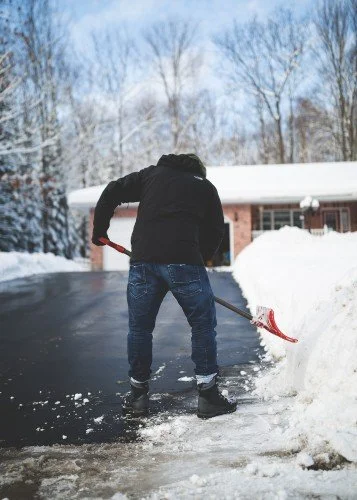8 Shoveling Techniques to Save Your Back This Winter Season
Shoveling can be the main cause of back injuries during the winter months however injuries can be prevented with proper shoveling techniques.
Some tips to avoiding lower back injuries this winter:
1. Pick the right shovel - Good Equipment is Key.
The right shovel could save you from future injuries. There are many ergonomic shovels that can help take out the factor of back injuries. A shovel with a curved handle or an adjustable handle can minimize painful unnecessary bending from the waist. These shovels will require you to bend your knees all the while keeping the shovel blade parallel to the ground. Consider the weight of the shovel before buying. A lightweight shovel with a plastic blade can help reduce the amount of weight you are pushing. Additionally, using a back support belt to keep your body aligned will further support your body as you head out for the second, third, or even fourth round of clearing away the snow.
2. Warm up your muscles thoroughly before getting out there.
Tight muscles that are not warmed up are prone to more injuries than warmed up loose warmed muscles. It is suggested that a 5-10 minute warm up before strenuous work can save your body from potential pain and injury.
Some ways to get your body warmed up are:
March in place raising your knees up,
A quick gentle yoga stretch session
Take a brisk walk around the block to get your blood moving
Stretch your lower back and hamstrings.
Do some gentle lunges, making sure to keep your knees in line with your feet. Limit twisting!
Limber up your arms and shoulders by wrapping your arms around you and holding between 30-60 seconds.
Keeping your core muscles strong can help withstand the strains of winter shovelling. By having strong core muscles it can help protect, support, and stabilize your spine.
3. Use proper ergonomic lifting techniques to maintain good shoveling posture.
Push the snow to one side instead of lifting it, especially if it is heavy wet snow. Lifting can cause a risk for neck and lower back injuries.
Lifting techniques:
Face toward the object you intend to lift - hips and shoulders should be square to the object.
Bend at the hips, not at the lower back, push the chest forward, bend your knees and lift with your leg muscles, make sure to keep your back straight.
Lighten the load and don't lift something that's too heavy for you.
If you have to lift the shovel when it is full, grip the shovel comfortably. Hold it closer to the blade with the other hand on the handle. When gripping the shovel keep your hands roughly 12-15 inches apart to provide proper stability and minimize lower back injury. Lift with your legs in the process not with your lower back or shoulders.
Avoid twisting your body or using awkward motions. Pivot your whole body (feet to head) to move the snow in a new direction. Keep your spine in line. Repetitive twisting can hurt your body.
Don't try to throw snow to a new location. That motion can strain muscles in your arms, shoulders and lower back.
4. Go slow, pacing yourself is important - breaks can save you in the long run.
Shovelling small amounts frequently is less strenuous than shovelling a large pile at once. It may take you longer but it is important to pace yourself and save yourself the trouble of trying to get it done fast by hurting your back in the process. Some people can attest to the saying, "What you save in time you gain in pain." This is true, go slow and pace yourself accordingly to the task at hand.
Pace yourself by:
Removing snow over a period of days will lessen the strain on your back and arms.
If the snow is deep, remove a few inches off the top at a time. Don't go the whole depth.
Take short breaks every 10-15 minutes; on your break stretch your arms, shoulders and back to keep them warm.
5. Always have your feet on the ground.
Ice could be under the snow, if you're not careful slips and falls can cause serious injury. Invest in good boots with a thick tread to increase traction and reduce your likelihood of falling on ice or slippery snow.
6. Use a snowblower.
A snowblower can make clearing snow both faster and easier on your body. Avoid putting any stress on your back by using your legs to power and push the snow blower while keeping your back straight and knees bent.
7. Get help from family, friends, or volunteers.
Many hands make light work! Make sure to show them the proper techniques for shovelling before you start!
8. Hydrate after you are finished.
Hydration is key to keeping your muscles at their best. You've probably worked up a sweat so it is important to keep yourself hydrated. This helps your muscles and joints get the blood, oxygen and nutrients they need to heal and repair. It also helps ward off stiffness and soreness.
Break bad habits by utilizing these proper shovelling techniques so you can save your back this winter!



